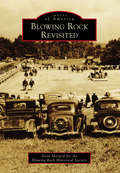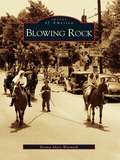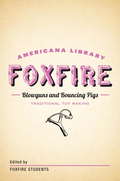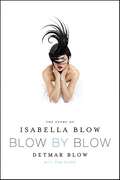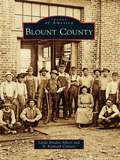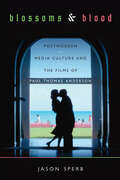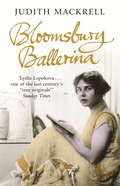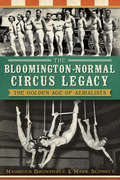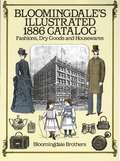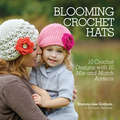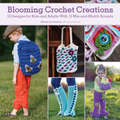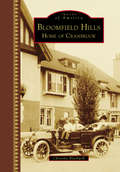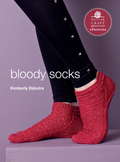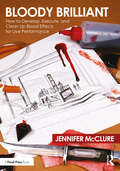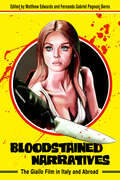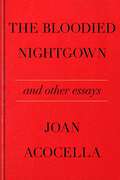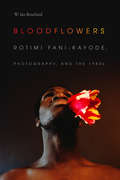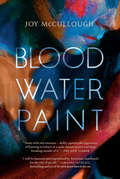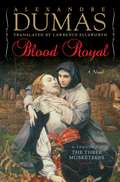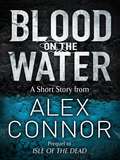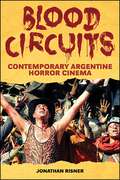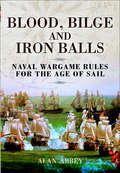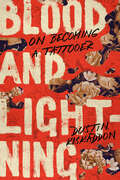- Table View
- List View
Blowing Rock Revisited
by Trent Margrif Blowing Rock Historical SocietyVoted "the Prettiest Small Town in North Carolina" and often referred to as the Crown of the Blue Ridge, Blowing Rock is the highlight of the High Country. Named for a unique, natural feature itself, Blowing Rock has always represented a distinctive blend of natural and cultural heritage. The town was first developed as an early resort area, which grew quickly in the 1890s. Modern boardinghouses, hotels, and inns were the first significant businesses in Blowing Rock and helped the town survive--even flourish--during the Great Depression. Added attractions in the 1950s and 1960s made Blowing Rock a year-round vacation paradise for families, which it still is today. Yet the heart of Blowing Rock lies within its community and residents who make their small town a wonderful place to visit and an even better place to live.
Blowing Rock
by Donna Akers WarmuthThe beautiful and mountainous area of Blowing Rock, North Carolina, has a rich history dating back to the days when the Native Americans passed through on the Nickajack Trail, which led into Tennessee. The town derives its unique name from a rock outcropping near the town, where the winds defy gravity and have the ability to blow light objects thrown from the rock back to the rock. During the 1790s, several families settled the area, and by the mid-1850s, inhabitants of Blowing Rock along with summer visitors from Lenoir enjoyed the beauty and comfort of the mountainous area. The construction of the Lenoir-Blowing Rock Turnpike after 1845 provided easier access to "America's Switzerland," and visitors or "cottagers," as they were called, soon began building second homes in the area. The images contained within Blowing Rock provide readers with a glimpse into the small-town charm, friendly faces, and inspiring scenery that ensure the town's future as a destination for those who yearn for the comfort of mountain life.
Blowguns and Bouncing Pigs: The Foxfire Americana Library (6) (The Foxfire Americana Library)
by Inc. Foxfire FundThe Foxfire Americana Library takes you back to the good ol' days with a collection of simple, classic toys that can be made at home. Complete with illustrated step-by-step instructions, "Blowguns and Bouncing Pigs" includes advice on how to make: Ball and CupsBlowgunsBouncing PigsBows and ArrowsBubble BlowersBull GrindersButtons on a StringClimbing BearsCorn GunsCornstalk AnimalsCornstalk FiddleApple-head DollsCucumber DollsFluttermillsFly GunsHoopsJumping JacksKicking MulesLimberjacksPop GunsPuzzlesRattletrapsRolling ClownsSling ShotsSmoke GrindersSquirt GunsStick HorsesStiltsGrapevine SwingsRope SwingsTops or DancersWhimmy Diddles or Jeep SticksHollow WhistlesSplit WhistlesWhittled Animals
Blow by Blow: The Story of Isabella Blow
by Detmar Blow Tom Sykes“One of the most original and influential people of the twentieth century to me and many others.” —Alexander McQueenWith a career spanning thirty years in fashion, as an influential voice at Vogue, Tatler, and The Sunday Times Magazine—as well as a legacy as one of the industry’s kingmakers for discovering Philip Treacy, Alexander McQueen, Sophie Dahl, and Hussein Chalayan—Isabella Blow had been a pillar of couture culture until her suicide in 2007 left the fashion world mourning one of its finest friends and patrons. Blow by Blow is a captivating journey through Issie’s life, a one-of-a-kind look at her unforgettable impact on the fashion world, and a moving exploration of her inspiring and ultimately tragic tale.
Blount County (Images of America)
by B. Kenneth Cornett Linda Braden AlbertBlount County is the 10th county formed in the state of Tennessee. It was carved out of Knox County in 1795 and named for William Blount, the governor of the Territory South of the River Ohio. Maryville is the county seat and was named for Blount's wife, Mary Grainger Blount. The abundance of natural resources that once drew hardy settlers now attracts tourists from all over the world, especially to Cades Cove, a pioneer settlement in the Blount County section of Great Smoky Mountains National Park. Blount County has been home to the legendary Sam Houston; U.S. Senator Lamar Alexander, who also served as Tennessee's governor; and Bessie Harvey, a world-renowned folk artist.
blossoms & blood: Postmodern Media Culture and the Films of Paul Thomas Anderson
by Jason SperbFrom his film festival debut Hard Eight to ambitious studio epics Boogie Nights, Magnolia, and There Will Be Blood, Paul Thomas Anderson's unique cinematic vision focuses on postmodern excess and media culture. In Blossoms and Blood, Jason Sperb studies the filmmaker's evolving aesthetic and its historical context to argue that Anderson's films create new, often ambivalent, narratives of American identity in a media-saturated world. Blossoms and Blood explores Anderson's films in relation to the aesthetic and economic shifts within the film industry and to America's changing social and political sensibilities since the mid- 1990s. Sperb provides an auteur study with important implications for film history, media studies, cultural studies, and gender studies. He charts major themes in Anderson's work, such as stardom, self-reflexivity, and masculinity and shows how they are indicative of trends in late twentieth-century American culture. One of the first books to focus on Anderson's work, Blossoms and Blood reveals the development of an under-studied filmmaker attuned to the contradictions of a postmodern media culture.
Bloomsbury Ballerina: Lydia Lopokova, Imperial Dancer and Mrs John Maynard Keynes
by Judith MackrellThe story of the splendidly unpredictable Russian dancer who ruffled the feathers of the Bloomsbury set and became the wife of John Maynard KeynesBorn in 1891 in St Petersburg, Lydia Lopokova lived a long and remarkable life. Her vivacious personality and the sheer force of her charm propelled her to the top of Diaghilev's Ballet Russes. Through a combination of luck, determination and talent, Lydia became a star in Paris, a vaudeville favourite in America, the toast of Britain and then married the world-renowned economist, and formerly homosexual, John Maynard Keynes.Lydia's story links ballet and the Bloomsbury group, war, revolution and the economic policies of the super-powers. She was an immensely captivating, eccentric and irreverent personality: a bolter, a true bohemian and, eventually, an utterly devoted wife.
Bloomsbury Ballerina: Lydia Lopokova, Imperial Dancer and Mrs John Maynard Keynes
by Judith MackrellThe story of the splendidly unpredictable Russian dancer who ruffled the feathers of the Bloomsbury set and became the wife of John Maynard KeynesBorn in 1891 in St Petersburg, Lydia Lopokova lived a long and remarkable life. Her vivacious personality and the sheer force of her charm propelled her to the top of Diaghilev's Ballet Russes. Through a combination of luck, determination and talent, Lydia became a star in Paris, a vaudeville favourite in America, the toast of Britain and then married the world-renowned economist, and formerly homosexual, John Maynard Keynes.Lydia's story links ballet and the Bloomsbury group, war, revolution and the economic policies of the super-powers. She was an immensely captivating, eccentric and irreverent personality: a bolter, a true bohemian and, eventually, an utterly devoted wife.
Bloomsbury: A House of Lions
by Leon Edel"A House of Lions" is a series of biographical essays on the principal figures in the "Bloomsbury Group" -- writers, painters, critics, economic and political activists who came together during the Edwardian period and flourished beyond the Second World War.
Bloomington-Normal Circus Legacy, The: The Golden Age of Aerialists
by Maureen Brunsdale Mark SchmittStarting in the 1870s, the barns, icehouses, gymnasiums and empty theaters of central Illinois provided the practice sites for aerial performers whose names still command reverence in the annals of American circus history. Meet Fred Miltimore and the Green Brothers, runaways from the Fourth Ward School who became the first Bloomington-born flyers. Watch Art Concello, a ten-year-old truant, become first a world-class flyer, then a famous trapeze impresario and finally Ringling Brothers and Barnum and Bailey Circus's most successful general manager. The entire art of the trapeze--instruction, training, performance and management--became a Bloomington-Normal industry during the tented shows' golden age, when finding a circus flying act without a connection to this area would have been virtually impossible.
Bloomingdale's Illustrated 1886 Catalog: Fashions, Dry Goods And Housewares
by Bloomingdale BrothersIn the spring and summer of 1886, a popular New York department store advertised its wares in a finely illustrated catalog featuring everything from clothing, accessories, and housewares, to jewelry, leather goods, school supplies, and dry goods. This excellent reproduction of that now-rare Bloomingdale Brothers catalog provides fascinating views of approximately 1,700 mid-Victorian consumer items (all finely drawn and easy to reproduce) together with the original descriptive captions.An informative introduction by Nancy Villa Bryk, Curator of Domestic Life at the Henry Ford Museum and Greenfield Village, precedes an entertaining panorama of fashions and other articles that include a stylish boucle jacket trimmed in velvet, a woman's tight-waisted riding costume, a variety of little girls' checkered pinafores (averaging about 35 cents apiece), infants' bibs, nurses' caps and aprons, men's nightshirts, suspenders, and smoking jackets; hosiery, hair goods, notions, parasols, silverware, toys, upholstery goods, fine millinery, delicate white laces, exquisite gold jewelry (remarkably inexpensive by today's standards), as well as "willow ware, walking sticks, zephyr worsteds, and fancy articles."Artists and designers will find this catalog a splendid sourcebook of copyright-free period graphics; antique collectors, historians, costume enthusiasts, and nostalgia lovers will find it indispensable for dating and identifying antiques, clothing, and other vintage items.
Blooming Crochet Hats: 10 Crochet Designs with 10 Mix-and-Match Accents
by Shauna-Lee GrahamCrochet a colorful hat with mix-and-match blooms! In Blooming Crochet Hats, you'll find a posie of patterns! Each of the ten hats is available in six sizes, ranging from infant to adult. From the adorable Scalloped Beanie to the fashionable Comfy Cloche, there's a hat for everyone to make and enjoy. Add a newsboy band, a sunhat brim or earflaps to give your hat a different look, and once you're done, button on one of the ten interchangeable motifs to make it uniquely your own! With an assortment of flowers, like carnation puffs and cherry blossoms, as well as novelty designs like bears and butterflies, you'll be able to match your hats to any outfit or occasion.
Blooming Crochet Creations: 10 Designs for Kids and Adults With 15 Mix-and-Match Accents
by Shauna-Lee GrahamCrochet fun for everyone!Five accessories for children and five accessories for adults with fifteen new interchangeable motifs makes Blooming Crochet Creations a garden of delights for the whole family. Make travel fun and easy with the Popping Chevron Blanket, Shoulder Pack and Tick-Tac-Toe Travel Game, or update your wardrobe with the Boho Shrug, Frilled Leg Warmers and Scalloped Fingerless Gloves. Your little ones will love their cute Bloomers & Britches, and the Large Market Bag will make grocery shopping a snap. And with fifteen new motifs, you'll be able to change the accents on your crochet items every day of the week!
Bloomfield Hills: Home of Cranbrook (Images of America)
by Christine BlackwellBloomfield Hills is an affluent suburban city located 20 miles north of downtown Detroit. During the late 19th and early 20th centuries, much of the area's rolling farmland was purchased by wealthy Detroit residents who had first discovered "the hills" when they went touring northward in their new horseless carriages. Seeking refuge from Detroit's summer heat and crowds, the newcomers built weekend homes that ranged from elaborate farmhouses to large manor estates. Philanthropists George Gough Booth and his wife, Ellen Scripps Booth, envisioned more than a manor house for themselves, however, and built what is now a National Historic Landmark, the Cranbrook Educational Community. In 1932, Bloomfield Hills incorporated as a city. The city retains its mystique as an enclave of elegant living and exceptional schools, but its history also includes instances of poverty and mayhem. It is all here in Images of America: Bloomfield Hills: Home of Cranbrook.
Bloody Socks: E-Pattern from Vampire Knits (Potter Craft ePatterns)
by Kimberly DijkstraInstructions for making socks.
Bloody Brilliant: How To Develop Execute And Clean Up Blood Effects For Live Performance
by Jennifer McClureBloody Brilliant: How to Develop, Execute, and Clean Up Blood Effects for Live Performance offers methods and techniques for delivering this special effect on the stage. The world of live theatre presents its own set of unique challenges when creating special effects, particularly blood. There are no cropped-view frames, multiple angles, or reshoots – everything is live and in view of the audience. This book provides helpful insight, information, techniques, and tricks for producing reliable and repeatable blood effects, covering everything from design and budgeting to safety and clean-up. Filled with easy-to-follow descriptions and full-color artwork, this text includes: Practical examples of blood effect budgets, outlining not just money but also labor needs. A breakdown of the components for making an original blood recipe, as well as reliable, industry-tested recipes. Options for dispensing blood to create realistic effects for any budget size. A comprehensive wash-testing database of over 500 examples of fabrics and blood combinations. Prop managers and builders in professional, educational, and regional theatre are sure to benefit from the tips outlined in this book.
Bloodstained Narratives: The Giallo Film in Italy and Abroad (Horror and Monstrosity Studies Series)
by Matthew Edwards and Fernando Gabriel Pagnoni BernsContributions by Donald L. Anderson, Brian Brems, Eric Brinkman, Matthew Edwards, Brenda S. Gardenour Walter, Andrew Grossman, Lisa Haegele, Gavin F. Hurley, Mikel J. Koven, Sharon Jane Mee, Fernando Gabriel Pagnoni Berns, Émilie von Garan, Connor John Warden, and Sean WoodardThe giallo (yellow) film cycle, characterized by its bloody murders and blending of high art and cinematic sleaze, rose to prominence in Italy in the 1960s and 1970s. Beginning with Mario Bava’s The Girl Who Knew Too Much (1963) and Dario Argento’s The Bird with the Crystal Plumage (1970), giallo films influenced the American slasher films of the 1980s and attracted an increasingly large fandom. In Bloodstained Narratives: The Giallo Film in Italy and Abroad, contributors explore understudied aspects of gialli. The chapters introduce readers to a wide range of films, including masterpieces from Argento and overlooked gems, all of them examined in close detail. Rather than understanding giallo as focalized exclusively in Italy in the 1970s, this collection explores the extension of gialli narratives abroad through different geographies and times. This book examines Italian gialli of the 1970s as well as American neo-gialli, French productions, Canadian horror films of the 1980s, and Asian rewritings of this “yellow” cycle of crime/horror films. Bloodstained Narratives also features interviews with two giallo film directors, including cult favorite Antonio Bido. Rather than fading from the cinematic stage, gialli serves as a precursor and steady accomplice to horror-thriller films through the twenty-first century.
The Bloodied Nightgown and Other Essays
by Joan AcocellaA collection of the New Yorker critic's finest essays, which examine the books that reveal and record our world.Joan Acocella was “one of our finest cultural critics” (Edward Hirsch), and she had the rare ability to examine literature and unearth the lives contained within it—its authors, its subjects, and the communities from which it springs. In her hands, arts criticism was a celebration and an investigation, and her essays pulse with unadulterated enthusiasm. As Kathryn Harrison wrote in The New York Times Book Review, “Hers is a vision that allows art its mystery but not its pretensions, to which she is acutely sensitive. What better instincts could a critic have?”The Bloodied Nightgown and Other Essays gathers twenty-four essays from the final decade and a half of Acocella’s career, as well as an introduction that frames her simple preoccupations: “life and art.” In agile, inspired prose, she moves from J. R. R. Tolkien’s translation of Beowulf to the life of Richard Pryor, from surveying profanity to untangling the book of Job. Her appetite (and reading list) knew no bounds. This collection is a joy and a revelation, a library in itself, and Acocella is our dream companion among its shelves.Includes 25 black-and-white images
Bloodflowers: Rotimi Fani-Kayode, Photography, and the 1980s (The Visual Arts of Africa and its Diasporas)
by W. Ian BourlandIn Bloodflowers W. Ian Bourland examines the photography of Rotimi Fani-Kayode (1955–1989), whose art is a touchstone for cultural debates surrounding questions of gender and queerness, race and diaspora, aesthetics and politics, and the enduring legacy of slavery and colonialism. Born in Nigeria, Fani-Kayode moved between artistic and cultural worlds in Washington, DC, New York, and London, where he produced the bulk of his provocative and often surrealist and homoerotic photographs of black men. Bourland situates Fani-Kayode's work in a time of global transition and traces how it exemplified and responded to profound social, cultural, and political change. In addition to his formal analyses of Fani-Kayode's portraiture, Bourland outlines the important influence that surrealism, neo-Romanticism, Yoruban religion, the AIDS crisis, experimental film, loft culture, and house and punk music had on Fani-Kayode's work. In so doing, Bourland offers new perspectives on a pivotal artist whose brief career continues to resonate with deep aesthetic and social meaning.
Blood Water Paint
by Joy McCullough<P><P>Her mother died when she was twelve, and suddenly Artemisia Gentileschi had a stark choice: a life as a nun in a convent or a life grinding pigment for her father's paint. <P><P>She chose paint. <P><P>By the time she was seventeen, Artemisia did more than grind pigment. She was one of Rome's most talented painters, even if no one knew her name. But Rome in 1610 was a city where men took what they wanted from women, and in the aftermath of rape ,Artemisia faced another terrible choice: a life of silence or a life of truth, no matter the cost. He will not consume my every thought. <P><P>I am a painter. <P><P>I will paint. <P><P>Joy McCullough's bold novel in verse is a portrait of an artist as a young woman, filled with the soaring highs of creative inspiration and the devastating setbacks of a system built to break her. <P><P>McCullough weaves Artemisia's heartbreaking story with the stories of the ancient heroines, Susanna and Judith, who become not only the subjects of two of Artemisia's most famous paintings but sources of strength as she battles to paint a woman's timeless truth in the face of unspeakable and all-too-familiar violence. I will show you what a woman can do.
Blood Royal: A Sequel To The Three Musketeers
by Alexandre DumasThe latest entry in this acclaimed series of new translations of the Musketeer novels, Blood Royal continues the adventures of the valiant d&’Artagnan and his three loyal friends.The latest translation in Lawrence Ellsworth&’s acclaimed new series of Alexandre Dumas&’s greatest adventures is Blood Royal, the second half of what Dumas originally published as Twenty Years After. In this volume all the plots and schemes set up in the previous novel come to dramatic fruition in the kind of exciting thrill-ride Dumas is famous for—while at the same time introducing the characters and themes that form the foundation of the rest of the series, leading to its great climax in The Man in the Iron Mask. In Blood Royal, the Four Musketeers all venture to England on parallel missions to save King Charles I, pursued by the murderous and vengeful Mordaunt, the son of Milady de Winter, the great villain of The Three Musketeers. Despite all his experience, d&’Artagnan is repeatedly foiled by the much-younger Mordaunt, who erupts out of the past to embody the strengths of audacity and cunning that were once d&’Artagnan&’s hallmarks. Mordaunt has corrupted those youthful strengths, and the older d&’Artagnan is no match for him until he is able to pull his former team together again. To do this d&’Artagnan will have to become a true leader of men, leading not just by example but also by foresight, persuasion, and compromise. Only then can the team of Athos, Porthos, and Aramis be re-formed in all its might to defeat the specter of their past. Blood Royal is unmatched in Dumas&’s oeuvre in its depictions of his most famous and beloved characters, and an unforgettable saga of swordplay, suspense, revenge, and ultimate triumph.
Blood on the Water
by Alex ConnorA short story from Alex Connor - a prequel to Isle of the Dead. A London art dealer comes to Venice after his wife dies and finds a corpse in a canal...
Blood Circuits: Contemporary Argentine Horror Cinema (SUNY series in Latin American Cinema)
by Jonathan RisnerArgentina is a dominant player in Latin American film, known for its documentaries, detective films, melodramas, and auteur cinema. In the past twenty years, however, the country has also emerged as a notable producer of horror films. Blood Circuits focuses on contemporary Argentine horror cinema and the various "cinematic pleasures" it offers national and transnational audiences. Jonathan Risner begins with an overview of horror film culture in Argentina and beyond. He then examines select films grouped according to various criteria: neoliberalism and urban, rural, and suburban spaces; English-language horror films; gore and affect in punk/horror films; and the legacies of the last dictatorship (1976–1983). While keenly aware of global horror trends, Risner argues that these films provide unprecedented ways of engaging with the consequences of authoritarianism and neoliberalism in Argentina.
Blood, Bilge and Iron Balls: Naval Wargame Rules for the Age of Sail
by Alan AbbeyBlood, Bilge and Iron Balls is a set of wargame rules for naval battles in the age of sail. With them you can recreate the triumphs of Nelson or Hawke or tackle pirates on the Spanish Main. The rules themselves are very simple and easy to learn. Each player can easily command a single ship or several, the rules working equally well for a single frigate chasing down a privateer, or a large-scale fleet action with multiple players on each side. The basic rules have been written with the emphasis on providing a fast-playing and fun game, but optional rules are included which will add a greater level of historical realism and detail. A unique card-driven turn sequence prevents the game becoming too predictable. Also included are a selection of scenarios for re-fighting specific historical battles and simple campaign rules. Although intended for use with model ships, the rule book includes sheets of ship counters which can be used to get started. Just add dice, tape measure and pencil and you're ready to play.
Blood and Lightning: On Becoming a Tattooer
by Dustin KiskaddonAny tattoo is the outcome of an intimate, often hidden process. The people, bodies, and money that make tattooing what it is blend together and form a heady cocktail, something described by Matt, the owner of Oakland's Premium Tattoo, as "blood and lightning." Faced with the client's anticipation of pain and excitement, the tattooer must carefully perform calm authority to obscure a world of preparation and vigilance. "Blood and lightning, my dude"—the mysterious and intoxicating effect of tattooing done right. Dustin Kiskaddon draws on his own apprenticeship with Matt and takes us behind the scenes into the complex world of professional tattooers. We join people who must routinely manage a messy and carnal type of work. Blood and Lightning brings us through the tattoo shop, where the smell of sterilizing agents, the hum of machines, and the sound of music spill out onto the back patio. It is here that Matt, along with his comrades, reviews the day's wins, bemoans its losses, and prepares for the future. Having tattooed more than five hundred people, Kiskaddon is able to freshly articulate the physical, mental, emotional, and moral life of tattooers. His captivating account explores the challenges they face on the job, including the crushing fear of making mistakes on someone else's body, the role of masculinity in evolving tattoo worlds, appropriate and inappropriate intimacy, and the task of navigating conversations about color and race. Ultimately, the stories in this book teach us about the roles our bodies play in the social world. Both mediums and objects of art, our bodies are purveyors of sociocultural significance, sites of capitalist negotiation, and vivid encapsulations of the human condition. Kiskaddon guides us through a strangely familiar world, inviting each of us to become a tattooer along the way.
